Roden 1/48 Arado Ar-68E
The Airplane:
Following the 1932 success of the Ar-65 as the airplane that would become the first fighter of the re-born Luftwaffe, Arado commenced work on two diferent prototypes of successor fighters, the Ar-67 and AR-68. The Ar-67 was dropped when the Luftfahrtkommissariat determined it did notr offer a sufficient advance over the Ar-65 to merit continued development. The Ar-68 was a larger and heavier design. With the assurance of the Luftfahrtkommissariat that the new Jumo 210 powerplant would be ready for installation in production fighters in 1935, the fighter was designed for this engine. Development received low priority since the He-51 had been chosen as the Ar-65 successor. Construction of the prototype D-I KIN commenced in the late summer of 1935 and it first flew in June 1934, powered by the BMW VId engine.
The prototype was successful from the outset in terms of handling and maneuverability, though speed and climb were only marginally better than the Ar-65 due to retention of the lower-powered engine. The new Jumo 210 was installed in the second and third prototypes, the Ar-68b D-IVUS and Ar-68c D-IBAS, the first armed prototype, that joined the flight test program in April and June 1935 respectively. The Jumo 210 was supercharged and could maintain sea level power to 9,000m.
Arado expected an order for the new fighter in 1934, but the Luftwaffe fighter units, whose pilots had been trained on the docile and forgiving Ar-65 and were now experiencing difficulty transitioning to the more temperamental He-51. Since the Ar-68 was even more highly loaded and offered even higher approach speeds, it was felt that it did not improve on the He-51.
Ernst Udet, newly appointed as Inspector of Fighters and Dive Bombers, had flown the prototypes and considered the performance of the airplane to be a vast improvement over the He-51, which he believed did not demonstrate that “if it looks right, it is right.” In 1936, he organized a mock combat between himself in the Ar-68c and one of the Luftwaffe's most experienced pilots in an He-51. Shortly after takeoff, the outcome was no longer in doubt, as Udet effortlessly out-climbed, out-turned and generally outfought the Heinkel fighter. While the Arado was no faster than its opponent, the fighter excelled in maneuverability. With that, the Ar-68 was ordered into production.
While Arado was planning production of the Ar-68E with the Jumo 210Da with a two-speed supercharger, the Reichluftfahrtministerium (RLM)determined priority use of the Jumo engine should go to the new Bf-109 fighter, and the early series Ar-68 was to use the older BMW VI 7,3A engine as an interim measure. This was designated the Ar-68F-1 and entered squadron service in 1936. This had similar performance to the He-51, which had already been proven outclassed by the Soviet I-15 over Spain that fall. After only a few Ar-68Fs had been produced, the fighter was reassigned priority for the Jumo 210Da and production finally switched to the Ar-68E-1, which became the Luftwaffe's last production biplane fighter.
The Ar-68 equipped seven new Jagdgruppen as well as several He-51-equipped units during 1937, before replacement began in the spring of 1938 with the arrival of the Bf-109B. Three Ar-68Es were shipped to the Legion Condor's 3./J88 in Spain, where they served as night fighters, though they never achieved any success. With the advent of the 109 in the fighter units, some Ar-68s served as night fighters in Germany during 1939-40, before the airplanes were sent on to the Jagdfliegerschulen.
The Kit:
There have been two Ar-68E kits released in 1/48 before this kit from Roden. Airmodel's vacuform, released in the mid-1980s, was one of the first vacuform kits to have resin detail parts for the prop, struts, landing gear and cockpit. Classic Airframes kit, released around 2001, was a limited-run injection plastic kit. Having built both, I can say that, of the two, the Airmodel vacuform was far more accurate and resulted in a better-looking model that was actually easier to construct despite being a vacuform.
Roden released this Ar-68E last year. It is fully up to modern high-end limited-run kit quality. My only complaint was that the fabric upper surface of the upper wing was too much the old “hills and valleys” look, which I modified to a more accurate look. The kit provides decals for the three Ar-68E night fighters sent to Spain, and an Ar-68E night fighter in 70/71/65 camouflage. The Spanish Civil War airplanes are in overall RLM63.
Construction:
Quality wise, this kit is equal to the Roden 1/48 He-51B I reviewed back in 2016, and is about as difficult to construct - in other words, pretty easy.
The first thing I noticed, comparing the kit with photos, was the extreme “fabric effect” on the upper surface of the upper wing, the ailerons and the flaps. I sanded the upper wing flat, then scribed in rib tape. The ailerons and flaps were just sanded down a bit to knock off the extreme edges. This is my only complaint about the kit, and if you don't want to go to the lengths I did, you'll be fine; it's just a matter of personal taste. I assembled the upper wing with the ailerons in neutral position.
I then assembled the cockpit and painted it RLM02. I used some Eduard seatbelts to enhance the look. I glued the side flaps in the up position on the fuselage halves, since the small cockpit opening meant I didn't have to do more detail to the cockpit.
The engine cowling is separate, which shows Roden has at least the thought of doing the Ar-68F. I glued each half to its respective fuselage half so I could work the fit from inside and out.
There are no locating pins and holes for assembling the fuselage, but if you take care with fitting the halves here, you won't need to do more than scrape down the fuselage centerline.
The gear has both spats and the spatless configuration of the Ar-68s in Spain. The gear legs fit easily.
The tail surfaces were next. I posed the elevator down.
The lower wings were assembled with the flaps up in the neutral position. It's important when gluing the wings to the fuselage to get the proper dihedral - which is zero.
I glued the cabane struts in position. Once they were set up, I positioned the upper wing on them to get proper positioning of the interplan “N” struts and glued them to the lower wing.
Painting:
I preshaded the model with black along panel lines ane ribs, then shot the white wingtips and rudder. I masked those off and gave the model an overall coat of RLN63, which I mixed from Tamiya “Buff” and “RLM Grau.” When all was dry, I gave the model a coat of MicroScale “Gloss.”
Decals:
The Roden decals went on without problem.
Final Assembly:
I glued the upper wing in place, then gave the model an overall coat of Tamiya “Clear Flat.” I then applied some exhaust staining with Tamiya “Smoke.”
The simple interplane rigging was done with .03mm steel wire.
I then attached the prop and the windscreen.
Overall:
To my mind, the Ar-68E will never win a fight for looks with the He-51B, but the record is the real thing could take the Heinkel fighter in any other fight. The airplane is historically significant as the last produced Luftwaffe biplane fighter and thus deserves a place in any comprehensive Luftwaffe collection. The fact it served in the Spanish Civil War is also attractive for those interested in that conflict. As a biplane model, this is an easy one without a lot of rigging, so it's sure to please those who are hesitant about biplane kits who want the model in their collection. In fact, it would be a good “first biplane” for a modeler. Highly recommended for overall quality and accuracy. The Classic Airframes kit is now officially obsolete.
Review kit courtesy of Roden.
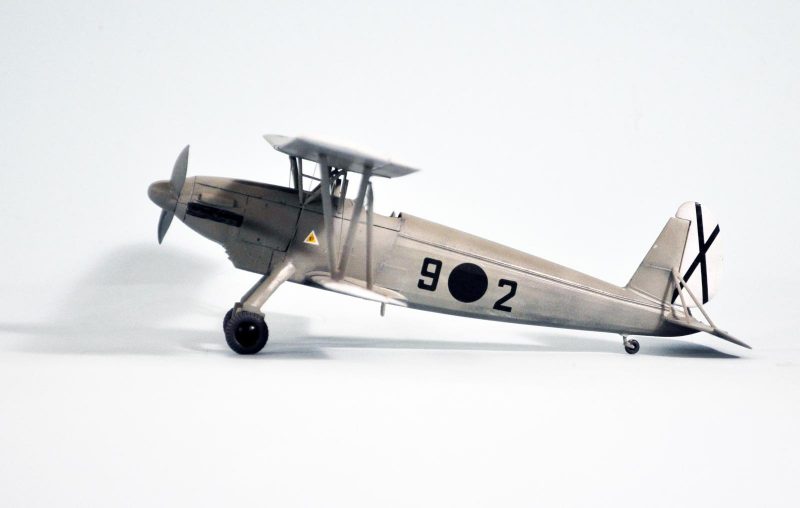
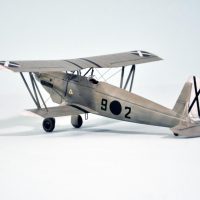
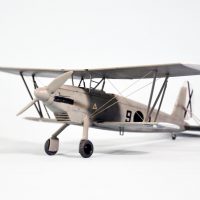
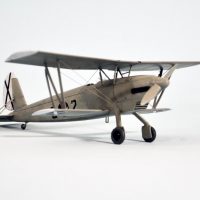
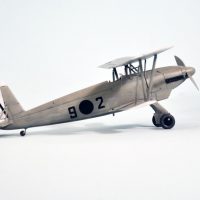
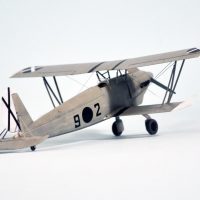

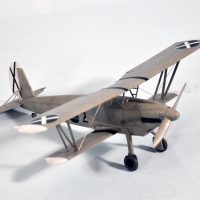
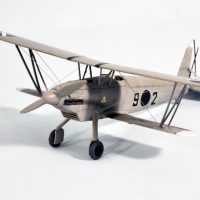
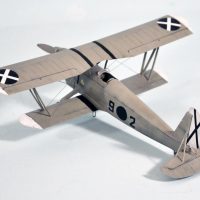
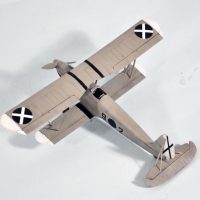
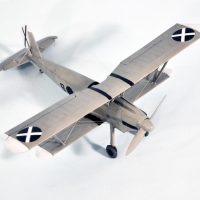
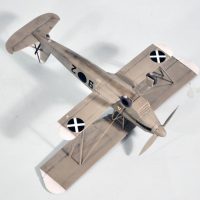
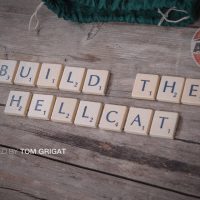
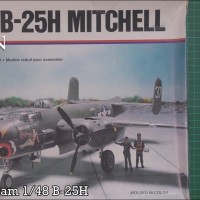
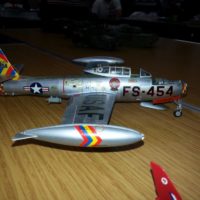
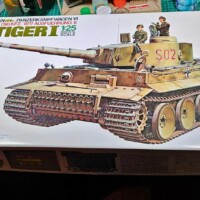
Great build, Tom!
Love the looks of the Spanish scheme.
Really good build and as always the history adds to the build and tops up my knowledge of the subject.
Another great build to add to your cabinet, Tom.
Always love it to read the background you add to your entries.
Great build as always Tom. ?
Nice work, Tom. I enjoy seeing SCW subjects. I’m glad the Roden decals worked.
Looks great Tom. I really like this .
Very nice! I wasn't much aware of this bird, and those "baby wings" on the bottom give it a very unusual look. Having just finished rigging an Fi-167 in 1/72, I can see why you would say this is a good "starter biplane!" I simply do not like rigging, which is why I steer away from bipes usually. (however, this is very cool, as is the Fi-167 - If I can find in 1/72 I'll add to my stash...)